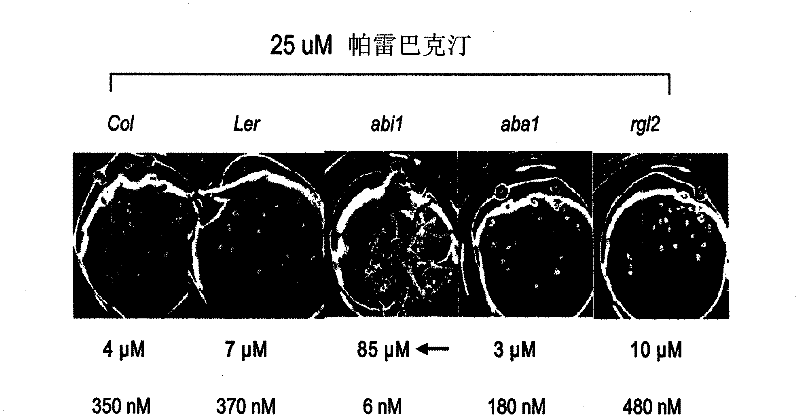Control of plant stress tolerance, water use efficiency and gene expression using novel aba receptor proteins and synthetic agonists
A technology of stress resistance and agonist, applied in botany equipment and methods, using vectors to introduce foreign genetic material, plant peptides, etc., can solve unclear problems
- Summary
- Abstract
- Description
- Claims
- Application Information
AI Technical Summary
Problems solved by technology
Method used
Image
Examples
Embodiment 1
[0274] Example 1: PYR / PYL regulates ABA signal transduction
[0275] Unlike biochemical screens for ABA-binding proteins, genetic analyzes focused on ABA sensing have not yet identified protein-assembling receptors, suggesting that receptors may be functionally redundant, have overlapping functions, or fail to mutate to produce viable gametes or seedlings (P . McCourt, Annual Review of Plant Physiology and Plant Molecular Biology 50, 219 (1999)). As a complementary approach, we adopted a chemogenetic strategy in plants (Y. Zhao et al., Nat Chem Biol 3, 716 (2007)). This method is suitable for organisms with highly redundant genomes, because the variable selectivity of small molecules can produce phenotypes that cannot be manifested by single gene mutations (N. Raikhel, M. Pirrung, PLANT PHYSIOLOGY 138, 563 (2005); S . Cutler, P. McCourt, Plant Physiol. 138, 558 (2005)). For example, low-sensitivity antagonists can interfere with the function of entire protein families (as ob...
Embodiment 2
[0300] Example 2: Screening of PYR / PYL agonists
[0301] We next investigated whether other compounds besides ABA and parebactin could act as agonists of PYR / PYL proteins. Yeast two-hybrid strains expressing the ABA receptor and type 2 protein C phosphatase in a suitable vector can be used to monitor the activity of the ABA receptor. Thus, these yeast strains create a convenient screening system for the identification of penetrant compounds that are ABA agonists, ie, compounds that promote the binding of PYR / PYL family members to their target protein phosphatases. When the PYR / PYL protein binds to the target PP2C in yeast two-hybrid, the reporter gene is activated, which, depending on the strain used, can result in the expression of a reporter construct such as a LacZ / β-galactosidase marker or in the Expression of nutritional reporter genes grown on auxotrophic media.
[0302] For these agonist assays, screening compounds are added to microwell plates and the appropriate yea...
Embodiment 3
[0305] Example 3: Phenotypic Analysis of PYR / PYL Overexpression and Loss of Function in Mutant Strains
[0306] Abscisic acid is a multifunctional plant hormone that is involved in a variety of plant protective functions, including bud dormancy, seed dormancy and / or ripening, leaf and fruit abscission, and in response to various biotic stresses (e.g., cold, heat, ). According to independent of CO 2 As a mechanism of concentration, ABA is also responsible for regulating stomatal closure. Since PYR / PYL receptor proteins regulate ABA signaling, these phenotypes can be modulated by modulating the expression of PYR / PYL. However, as discussed above, experiments with individual, triploid, and tetraploid Pyr / Pyl mutants showed that the PYL receptors PYL1, 2, and 4 are functionally redundant with PYR1 under the control of ABA response. In these experiments, we wondered whether other PYR / PYL receptors were functionally redundant with PYR1 in the control of plant protection functions...
PUM
 Login to View More
Login to View More Abstract
Description
Claims
Application Information
 Login to View More
Login to View More - R&D
- Intellectual Property
- Life Sciences
- Materials
- Tech Scout
- Unparalleled Data Quality
- Higher Quality Content
- 60% Fewer Hallucinations
Browse by: Latest US Patents, China's latest patents, Technical Efficacy Thesaurus, Application Domain, Technology Topic, Popular Technical Reports.
© 2025 PatSnap. All rights reserved.Legal|Privacy policy|Modern Slavery Act Transparency Statement|Sitemap|About US| Contact US: help@patsnap.com



